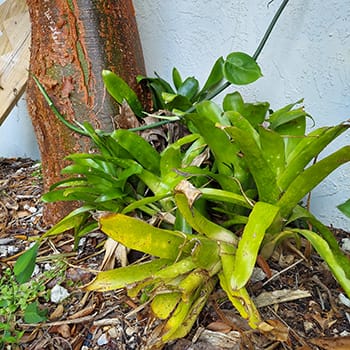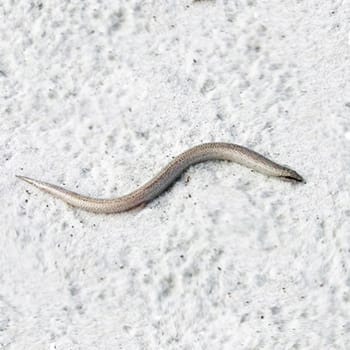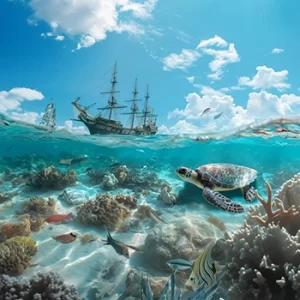
Florida Lizards: Most Common Types!
Florida lizards thrive in our warm and humid climate, which provides the perfect habitat for many lizard species. Whether you live in Florida, or visit for a few hours, you’ve been near lizards, whether you’ve seen them or not (they’re everywhere!).
There are roughly 40 lizard species in Florida, but there are 7 that are the most commonly encountered. And while some people get a little freaked out seeing lizards running around, these fast-little dinosaur-looking creatures are often misunderstood!


Have you seen these little brown lizards? They are small, fast and all over the place! If you haven’t seen one while in Florida… you haven’t been looking!
Florida Lizard Fun Facts
- Florida is home to a diverse range of lizard species (both native and invasive), currently more than 40 types!
- Florida Lizards play an important role in the ecosystem, including controlling insect populations (so leave them alone and wish them well!)
- The brown anole is the most common lizard found in Florida (if you haven’t seen them, you aren’t looking!)
- There are 7 types of lizards that are most commonly spotted throughout Florida: Brown Anole, Green Anole, Knight anole, Peter’s Rock Agama, Florida Sand Skink.
- Males use their dewlap (“throat fan”) for communicating dominance and when they’re looking for a mate. Some female anoles also have a brightly colored dewlap, but this behavior is mostly known to be used by males.

Can you name this type of lizard? (this one is a baby about 2 ft. long, hanging out on the window screen)

Can you name this one? He’s green and full grown, and a cousin to the lizard in the previous photo!
Different Florida Habitats = Different Lizard Species
Florida offers a variety of habitats that support different species of lizards. From the sandy beaches to the dense forests and marshes, lizards can be found in almost every corner of the state (and inside homes if you leave the door open too long)!
In the coastal areas, you can find species like the Green Anole and the Six-lined Racerunner. These lizards are well adapted to the sandy beaches and dunes, using their camouflage abilities to blend in with their surroundings.
In the wetlands and marshes, you can find species like the Eastern Fence Lizard and the Five-lined Skink. These lizards are excellent swimmers and can often be seen basking on logs or rocks near the water.
In the pine forests and oak hammocks, you may come across species like the Florida Scrub Lizard and the Southeastern Five-lined Skink. These lizards are well adapted to climbing trees and can often be found sunning themselves on branches.
Not sure what these lizards look like? Read on!



Role of Lizards in Florida's Ecosystem
Lizards play a crucial role in Florida’s ecosystem. They are important predators, feeding on insects and other small invertebrates.
By controlling populations of pests like mosquitoes and flies, lizards help to maintain a healthy balance in the ecosystem.
They also serve as prey for larger predators such as birds and snakes, contributing to the food chain.
Florida lizards also contribute to seed dispersal by consuming fruits and then excreting the seeds in different locations. This helps to spread plant species and promote biodiversity.
Additionally, lizards are important pollinators for certain plants, as they transfer pollen from one flower to another while feeding on nectar.

Can you spot the lizard?

He’s sitting on a green bromeliad!

The Most Common Lizards Found in Florida


Brown Anole (Anolis sagrei)
Brown Anole Lizard Facts
- Common name: “Brown Anole” and sometimes “Cuban Anole”
- Size range: typically 5-8 inches in length (including tail)
- Native or invasive: Not native but not considered invasive or problematic
- Region of Florida: Abundantly found throughout Florida (most common lizard)
- Habitat: Lives in most all Florida habitats and ecosystems
- Diet: insects, spiders, roaches (they eat what we don’t want to see!)
- Dewlap (throat fan): Used to attract mates and communicate, mostly males
Common brown anoles are the little brown lizards running around everywhere in Florida (biggest populations in South Florida). Native to Cuba and the Bahamas, the Brown Anole was introduced to Florida in the early 20th century and has since become one of the state’s most common lizard species.
Common misconception is that these little brown anoles can change color to green. In fact, the green ones that are similar in size are NOT brown anoles, they are green anoles (a different species). Brown anoles don’t change color.
Here’s a photo of a green anole and brown anole hanging out together on a wall in my backyard. They look like they’re friends. But experts say the brown anoles are more aggressive and territorial which threatens these native green anoles.

Brown anole with green anole.

Reddish “throat fan” is a dewlap.

Green Anole (Anolis carolinensis)
- Common name: Green Anole
- Size range: Typically 5-8 inches in length (including tail)
- Native or invasive: Native to southeastern United States
- Region of Florida: Commonly found throughout Florida, especially in the south
- Habitat: Tree-dwelling but competes for territory with the brown anole
- Diet: They mostly eat ants and other insects, and are considered very beneficial.
- Dewlap (throat fan): Used to attract mates and communicate dominance
- Green anoles CAN change color to brown, unlike their cousin brown anoles!
The Green Anole is one of the most common species of Anole found in Florida, and is an iconic lizard of the region. These tree-dwelling arboreal lizards are commonly found in wooded areas, parks, and gardens, where they display their vibrant green coloration.
Green anoles are often confused for baby iguanas, but up close, these green anoles look most like green versions of the cousin brown anole lizards.


A Knight Anole hanging on the screen outside my living room window.
Knight Anole (Anolis equestris)
- Common Name: Knight Anole also known as the Cuban Knight Anole
- Size range: typically 13-20 inches in length
- Native or invasive: Considered to be an invasive species, native to Cuba
- Region of Florida: Mostly South Florida but population is growing
- Habitat: Forests, shrubs, gardens and mostly tree-dwelling
- Diet: Insects, spiders, snails
- Dewlap (throat fan): Used to attract mates and communicate dominance
- They change color from bright green to dark brown-black
The Knight Anole is the largest of the anoles and a cousin to the green and brown anole. They are native to Cuba, but made their way to South Florida and their population continues to grow rapidly.
The Knight Anole can grow to 20 inches long, and when green they are easy to mistake for a green iguana.
Though they may be green or darker, they are easily identified by the yellow stripe running under their head underneath their black circled eyes.
Personal note: I live in South Florida and have lots of lizards in the backyard… and they all seem to live together in harmony.
Though they are known to be very territorial, my personal experience with the Knight Anole is seeing them in my backyard within feet of green iguanas, with zero animosity. (see the photos of my window, with a baby green iguana and a Knight anole sitting on my window both peering into my house!
Their coloring is dark but with a bright greenish-yellow strip on their face. To me they look like a small dinosaur and seem very smart, as if studying me while I’m studying them.



Peter's Rock Agama (Agama picticauda)
also known as "Rainbow Lizard"
This agama has a yellow head (instead of red) indicating he’s young. When he saw me, he stopped and froze as if I couldn’t see him ha ha ha aha haa!
- Common Name:
- Size range: 14-24 inches in total length, with males being larger than females
- Native or invasive: Considered invasive (native to Sub-Saharan Africa)
- Region of Florida: Mostly South Florida but adaptable with a growing population
- Habitat: Rocky outcrops, savannas, woodlands and… South Florida… like, everywhere!
- Diet: Primarily insectivorous, feeding on ants, grasshoppers, crickets, beetles, and other insects. They may also eat small lizards, snakes, birds, and mammals, as well as fruits and flowers.
This “Rainbow Lizard” is not native to Florida but has become a well-established resident. These sun-loving lizards thrive in rocky outcrops and open areas, basking on warm surfaces to regulate their body temperature.
Males, particularly during breeding season, are known for their striking appearance. Their bodies transform into a vibrant blue, contrasted by a fiery red or orange head.
Females and non-breeding males typically display a more subdued coloration, with brown or gray bodies and striped tails. When young, their heads may look yellow instead of red.
They are agile climbers and fast. They mostly eat insects, so they are beneficial to the Florida eco-system. And they pose no known threat to pets or people.


Agamas are quite a bit larger and thicker than the common brown lizards (anoles). They are very fast and love hiding out in trees and bushes.
They are NOT shy, and the have multiplied their population in South Florida exponentially and quickly.
The good news… they pose no threat to humans and they like to eat those gross cockroaches we all hate.

Brown Basilisk (Basiliscus vittatus)
- Size range: Adults can grow up to 2 feet in length (with length of tail)
- Native or invasive: Invasive, this species is native to Central America
The Brown Basilisk was introduced to Florida and has established breeding populations, particularly in the southern regions.
Known colloquially as the Jesus lizard for its remarkable ability to run on water, the Brown Basilisk can be seen around Florida’s many rivers and lakes.
Typically found near water sources such as canals, lakes, and streams, these lizards are known for their striking appearance and impressive athleticism.

Green Iguana (Iguana iguana)
- Size range: adults can reach lengths of 5 to 7 feet, including the tail
- Native or invasive: Invasive to Florida (native to Central and South America)
The Green Iguana was introduced to Florida and has established breeding populations, particularly in the southern regions.
While they were once considered to be a pet, now with their prolific population in Florida, they are considered a nuisance. There are businesses solely dedicated to iguana removal.
These large, herbivorous lizards are often seen basking in trees or near bodies of water, adding a tropical flair to Florida’s landscape. If you have a backyard pool, they will swim in it (and their poop will be everywhere).
Green iguanas dropping from trees is true.
Green iguanas have an odd behavior where, when temperatures drop to the 30’s… their bodies go into a state of dormancy and they will drop from trees seemingly frozen.
Some people think they’ve died, but in reality they are simply in a temporary state of what looks like paralysis, and once their body temperature warms, they (disturbingly) quickly jump right back into normal behaviors and will most likely run away and up into a tree to hide.

Green iguana in a tree by the sea

Green iguana at the front door


(left) Juvenile green iguana approximately 3 feet long including his long tail, basking on a rock on a sunny day (they love the heat from rocks).
(right) A baby green iguana on a window screen outdoors peering inside (they are very curious and smart, he’s approximately 1 foot long including his long tail).
Six-lined Racerunner (Aspidoscelis sexlineata)

- Size range: typically 6019 inches in length
- Native or invasive: Native to southeastern United States and Florida
This species of lizard inhabits open habitats like fields, sand dunes, and coastal scrubland.
Recognized for their incredible speed and agility, Six-lined Racerunners blend seamlessly into their surroundings with their six distinct stripes.
Encounter a Six-lined Racerunner in its natural habitat, and you’ll witness firsthand the beauty of nature’s design and adaptation.
Florida Scrub Lizard (Sceloporus woodi)

- Size range: typically 3 to 4 inches in length
- Native or Invasive: Native to Florida but its population is threatened
- Habitat: Sandy areas, scrublands
- Diet: Insets, spiders
The Florida Scrub Lizard is specially adapted to sandy scrub habitats, showcasing nature’s resilience in challenging environments. Their populations used to be much larger, but human population expansion through development and construction has affected this lizard species’ main habitats. It’s a hope that they will continue to adapt as needed, to keep their populations thriving.
These small lizards are often confused for brown anoles as they are the same basic size and shape, and similarly brownish. The main difference is that the male scrub lizard has a bright blue stripe towards his underbelly, and the females have a may have a slight bluish tone to their bellies.
Spotting a Florida Scrub Lizard amidst the scrubland is a testament to the importance of preserving the state’s unique ecosystems. Their numbers were far larger years ago. As population growth and construction hit all time highs, the natural habitat of these Florida Scrub Lizards gets smaller and smaller.
Here’s more about the Florida Scrub Lizard with a photo.
Florida Sand Skink (Plestiodon reynoldsi)
- Size range: adults are usually less than 6 inches in length
- Native or invasive: Native to Florida, mainly found in Central Florida
- Habitat: Sandy areas, dunes
- Diet: Insects, spiders, small lizards
The Florida Sand Skink is a small, secretive lizard that inhabits loose, sandy soils. It’s often mistaken, at first glance, for a snake.
With reduced limbs and a cryptic appearance, these lizards are expert burrowers, spending most of their time underground.
Encounters with the elusive Florida Sand Skink highlight the intricacies of Florida’s biodiversity and the importance of habitat conservation efforts.
Skinks can look like snakes at first glance, and there are many kinds of skinks in Florida. They are long and slender, and come in different colors.
Here’s more information on many different species of Florida skinks here, with photos.
Alligators?
Alligators are not lizards, though many people think of alligators as large lizards. However, they do share the scientific grouping of “Reptiles”. Lizards are technically closer relatives to snakes than alligators. But since alligators are so common in Florida these days, here’s a little information about them as well:



If you’re in Florida near water, chances are there could be an alligator!
They can be found in freshwater springs and rivers, and can also be spotted along the shore and in mangroves.
Sometimes alligators are even spotted swimming at the beach!
Alligators, decades ago, were considered threatened. And their population was subsequently protected. Today, there are more alligators in Florida than ever before!
Where’s the one place in Florida you’re almost guaranteed to see alligators in the wild? Visit the Florida Everglades!


Conclusion
Florida lizards play a vital role in the state’s ecosystem. Whether native or introduced, each species contributes to the rich tapestry of Florida’s wildlife.
By understanding and appreciating the complexities of Florida’s lizard fauna, we can work towards preserving their habitats and ensuring their continued presence for generations to come.
You may also like…









